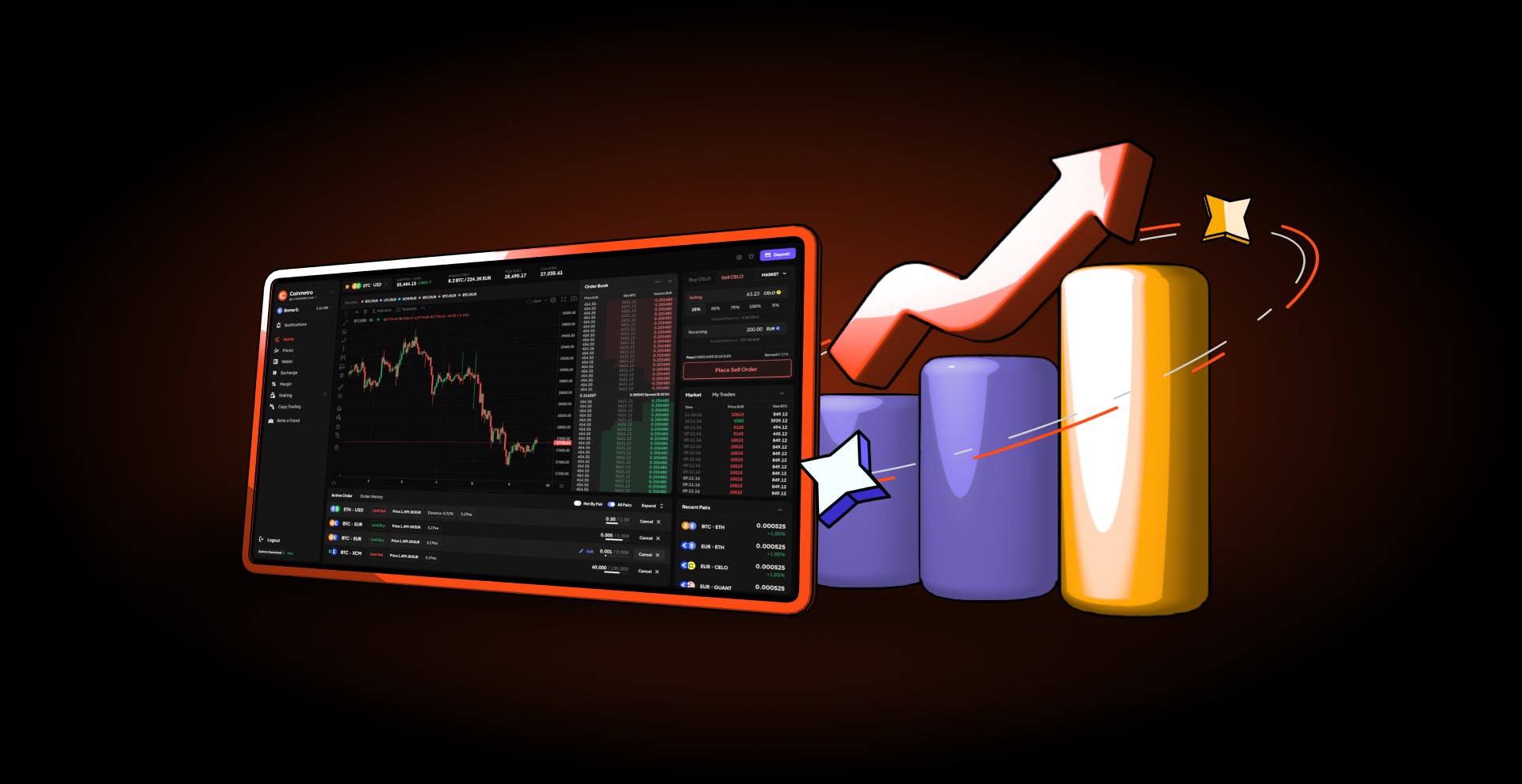The Mechanics of Spot Trading
December 5, 2025

by Kamil S
December 5, 2025
Spot trading is the heartbeat of the cryptocurrency world, where digital assets change hands in real-time. The great thing about spot trading is that it offers a straightforward and direct way to buy and sell cryptocurrencies. Unlike other trading methods like futures or options, spot trading involves the immediate exchange of digital assets at their current market prices. This simplicity makes it accessible to both beginners and experienced traders. With spot trading, you have full control over your assets, making it an excellent choice for those looking to invest or trade in the crypto market.
In this journey, we'll delve into the mechanics of spot trading, demystify order types, decipher the art of reading crypto charts, and explore advanced trading strategies. Along the way, we'll equip you with the knowledge to execute trades effectively and share insights on risk management. Whether you're a newcomer eager to learn the ropes or a seasoned trader looking to sharpen your skills, this comprehensive guide will deepen your understanding of crypto spot trading.
Before investing your hard-earned money in cryptocurrencies, conducting thorough research is not just a suggestion — it's a necessity. Make sure you equip yourself with the skills and insights required to make sound investment choices.
Understanding the Technology: Every cryptocurrency operates on a unique underlying technology, such as blockchain. It's crucial to grasp the technical fundamentals, like consensus mechanisms and scalability solutions, and evaluate a coin's potential for long-term success.
Assessing the Team: The people behind a cryptocurrency project play a pivotal role. Investigate the team's experience, expertise, and track record. A competent and transparent team is more likely to deliver on their promises.
Exploring Use Cases: Each cryptocurrency serves a specific purpose, from digital payments to smart contracts and decentralized applications (DApps). Evaluate the practicality and real-world utility of the coin or token you're considering.
Analyzing Market Dynamics: Stay informed about market trends, trading volumes, liquidity, and historical price data. Understanding market behavior can help you identify entry and exit points.
Security and Regulation: Security is paramount in the cryptocurrency space. Assess the coin's security measures and adherence to regulatory requirements in your jurisdiction. Make an effort to assess to what extent the project and its native asset may be affected by future developments in the regulatory landscape
Community and Adoption: A strong and active community can contribute to a cryptocurrency's success. Research online forums, social media channels, and developer communities to gauge the level of support and adoption.
Diversification and Risk Management: Consider diversifying your cryptocurrency portfolio to spread risk. Establish clear risk management strategies, including setting stop-loss orders and defining your investment horizon.
By diligently researching coins and tokens across these dimensions, you'll be better equipped to make informed investment decisions in the fast-paced world of cryptocurrencies. Remember that due diligence is a potent weapon against uncertainty and volatility in this market.
Leaving aside the evolution of individual cryptocurrency projects, it's crucial to recognize that the entire crypto market is subject to the influence of macroeconomic trends, political decisions, and various other news and events. These external factors can create significant ripples in the cryptocurrency markets, affecting prices and market sentiment on a broader scale. As a result, staying attuned to developments beyond the crypto sphere is essential for understanding the larger context in which cryptocurrency trading takes place and for making informed investment decisions.
Real-time news updates, including regulatory changes, technological advancements, or major partnerships, can profoundly affect trading decisions. Moreover, market sentiment, reflecting the collective attitude of traders and investors toward cryptocurrencies, can be a driving force behind price movements. Positive sentiment often leads to price surges, while negative sentiment can trigger sharp declines. Effectively navigating this landscape requires strategies such as setting up news alerts, following reliable sources, and utilizing sentiment analysis tools. Incorporating news and sentiment analysis into risk management strategies is equally essential for making informed decisions and mitigating potential losses.
Whether you're engaged in short-term or long-term trading, mastering the art of monitoring news and understanding market sentiment is a cornerstone of success. Investing in cryptocurrencies while remaining entirely disconnected from real-world events and developments is akin to navigating uncharted waters without a compass and may catch you off guard.
Now… Let’s carry on to the actual trading!
Your ability to navigate through various order options can significantly impact your trading success. In this section, we will delve into the fundamental concepts behind different order types, shedding light on their distinct characteristics and functions.
When it comes to executing trades, two primary order types stand out: Market Orders and Limit Orders. Understanding the differences between these two can be the key to precision in your trading strategy. We'll break down the nuances of Market Orders, where speed is paramount, and Limit Orders, which empower you with control over price execution.
Market Orders are all about speed. When you place a Market Order, you're telling the exchange to execute your trade immediately at the current market price. This means you're prioritizing execution speed over price precision. Market Orders are perfect for situations where you want to get in or out of a position quickly, regardless of the exact price you receive. However, keep in mind that in highly volatile markets, the actual execution price may differ slightly from what you see on your screen. This is commonly referred to as "slippage - an event that occurs due to rapid market fluctuations or delays in order execution. Slippage can result in traders buying or selling an asset at a price that is less favorable than they anticipated.
On the other hand, Limit Orders provide you with a high level of control over the price at which your trade is executed. With a Limit Order, you specify the maximum price you're willing to buy or the minimum price you're willing to sell an asset. Your order will only be executed if the market reaches or surpasses your specified price. This can be a valuable tool for traders who have a target entry or exit price in mind and are willing to wait for the market to meet their conditions.
Market Orders are ideal when speed is paramount, while Limit Orders give you control over price execution. Choosing between them depends on your trading goals, risk tolerance, and the market conditions you're operating in. A well-balanced trading strategy may involve using both order types strategically to maximize your trading outcomes.
Stop Orders are a powerful tool for managing risk and protecting your investments. Here, we'll explore the intricacies of Stop Orders and how they operate in various market scenarios.
A common and vital application of Stop Orders is in the form of "stop-loss" orders. These orders act as safety nets for your investments. When you set a stop-loss order, you specify a price level at which you want your position to be automatically sold if the market moves against you. This helps you limit potential losses and prevent a small setback from turning into a financial disaster.
In addition to stop-loss orders, there are "stop-limit" orders. These orders combine the features of both stop and limit orders, offering an extra layer of control. When your specified stop price is reached, a stop-limit order becomes a limit order, allowing you to define not only when you want to exit a trade but also the exact price at which you want to do so. This precision can be particularly useful in fast-moving markets, where a simple stop order might execute at a less favorable price due to slippage.
By understanding how to use stop-losses and stop-limit orders effectively, you can safeguard your trading positions from unexpected downturns and market volatility. These tools empower you to stick to your risk management strategy, providing you with greater confidence and control in your trading endeavors.
Do you want to read more about the nuances of crypto spot trading? Do it like a pro!

Moving on, charts are an essential tool in the world of trading and investing. They serve as visual representations of price data and market trends, offering valuable insights to traders and investors alike. The ability to interpret crypto charts is a fundamental skill, helping traders make informed decisions. In this section, we'll dive into the art of reading crypto charts, unraveling their complexities, and uncovering valuable insights they offer.
Candlestick patterns are a vital component of crypto chart analysis. These patterns carry significant meaning and can be powerful indicators when spotted on a crypto chart. They provide a detailed view of price action over a specific timeframe. Understanding these patterns can help traders anticipate market trends and reversals. However, it's important to be aware that while clear candlestick patterns can provide valuable insights, they are not an absolute guarantee of specific market behavior. Market dynamics can be influenced by various factors, and patterns should be considered as one of many tools in a trader's toolkit, rather than a foolproof prediction method. Some common candlestick patterns include:
Doji Patterns: A "Doji" pattern on a candlestick chart typically appears as a single candlestick with a small body, which means that the opening and closing prices are very close to each other, almost forming a horizontal line. This results in the candlestick resembling a cross or a plus sign. These patterns signal indecision in the market, often occurring at potential reversal points. Traders use them to anticipate trend changes.
Hammer Patterns: A "Hammer" pattern on a candlestick chart resembles the shape of an actual hammer, with a small body near the top of the candlestick and a long lower shadow or wick extending downward. The small body represents the opening and closing prices, which are usually near the high of the time period, while the long lower shadow extends below the body, indicating how far the price dipped during that period. Hammers typically appear at the end of downtrends and suggest potential bullish reversals. Learning to recognize hammers can be a valuable skill for traders.
Engulfing Patterns: An "Engulfing" pattern on a candlestick chart is a significant formation that occurs when one candle completely "engulfs" or covers the entire price range of the previous candle. It consists of two candles, with the second one being larger and completely overshadowing the first one. They are often seen as strong reversal signals.
Morning Star Patterns: A "Morning Star" pattern is a bullish reversal formation that frequently emerges on candlestick charts. It unfolds over three candles and is associated with a potential shift in market sentiment. Here's how it looks and what it signifies:
First Candle: The first candle is a bearish (red or black) candlestick, indicating a downtrend.
Second Candle: The second candle is a small-bodied candlestick that often has a gap down from the first candle. It represents a period of market indecision or uncertainty.
Third Candle: The third candle is a bullish (green or white) candlestick that closes well above the first candle's open, effectively "engulfing" the first candle. This upward momentum suggests a potential shift to a bullish trend.
The Morning Star pattern is considered a robust signal for potential bullish reversals. It reflects a transition from bearish sentiment (the first candle) to uncertainty (the second candle) and finally to bullish sentiment (the third candle). Traders often view this pattern as an indication that the downtrend may be losing steam, and a bullish reversal could be underway.
When it comes to trading in financial markets, executing a trade is the pivotal moment when you put your analysis and strategy into action. This section will guide you through the process of executing trades, from the initial decision to the final click.
Before you execute a trade, there are crucial steps to follow. Placing an order isn't just about buying or selling; it involves making strategic choices. Some important steps may include:
Define Your Objective: Start by clearly defining your trading objective. Are you looking for short-term gains, or is this a long-term investment? Understanding your goal will help shape your strategy.
Analyze the Market: Thoroughly analyze the market or asset you intend to trade. Use technical and fundamental analysis to gain insights into potential entry and exit points.
Set Your Risk Tolerance: Determine how much risk you're willing to take on this trade. Calculate the maximum amount you're willing to lose, known as your stop-loss level. Additionally, establish your "take profit" margin to define the point at which you plan to secure profits from a trade.
Choose Your Order Type: Select the appropriate order type based on your strategy. Market orders, limit orders, and stop orders each have their advantages and disadvantages, catering to various trading strategies.
Specify Order Details: Fill in the specifics of your order, including the quantity of assets you want to trade and the price at which you want the order to execute.
Review and Confirm: Before finalizing your order, review all the details to ensure they align with your strategy and risk tolerance.
Execute the Order: Once you're satisfied with the order details, execute the trade through the trading platform. Always be mindful of transaction costs.
Monitor Your Trade: After executing the order, continue to monitor the trade's progress. Keep an eye on price movements and be prepared to adjust your strategy if necessary.
By following these steps, you'll be well-prepared to place an informed and strategic trade, increasing your chances of achieving your trading objectives while managing risk effectively.
In the world of cryptocurrency investing, success often hinges on avoiding common pitfalls. This section will illuminate some of these mistakes and provide guidance on how to steer clear of them.
Overtrading is a widespread error among cryptocurrency enthusiasts. It occurs when investors make a flurry of trades, often driven by emotions rather than a well-defined strategy. Emotional decisions can lead to impulsive actions, such as buying in a frenzy when prices are soaring or panic-selling during market downturns. To avoid this mistake:
Establish a Clear Strategy: Develop a well-thought-out trading plan with predefined entry and exit points. Stick to your strategy even when emotions run high.
Set Realistic Goals: Define achievable goals for your trading activities. Understand that cryptocurrency markets can be highly volatile, and not every trade will yield substantial profits. Learn to take profits once you have reached your target.
Practice Discipline: Exercise discipline and restraint in your trading. While chasing quick gains could potentially pay off, it could also expose you to a lot of risk. It’s good that you remain patient in your investment approach at the beginning. Learn to stomach volatility and embrace a long-term perspective.
A significant misstep in cryptocurrency investing is the lack of diversification. Concentrating all your investments in a single cryptocurrency can potentially expose you to heightened risk. If that particular asset underperforms or faces unforeseen challenges, your entire portfolio could suffer. To steer clear of this error:
Diversify Your Portfolio: Consider spreading your investments across multiple cryptocurrencies with diverse use cases and potential for growth. This strategy helps reduce risk by not relying solely on the success of one asset.
Research and Due Diligence: Conduct thorough research on the cryptocurrencies you intend to invest in. Understand their underlying technology, market trends, and adoption potential before allocating your funds.
Rebalance Periodically: Regularly reassess your portfolio and adjust your holdings to maintain your desired level of diversification and risk. This ensures that your portfolio aligns with your long-term goals and with the dynamics in the larger economic landscape.
A critical mistake in cryptocurrency investing is ignoring security protocols. The cryptocurrency space is rife with security threats, from phishing attacks to exchange hacks. Neglecting basic security measures can expose your holdings to theft or loss. To avoid this blunder:
Use Reputable Crypto Exchanges & Cold Wallets: By opting for a reputable crypto exchange such as Coinmetro, and implementing the use of cold wallets like hardware wallets, you significantly reduce the risk of cyberattacks and unauthorized access to your valuable assets. This proactive security approach is essential in safeguarding your investments in the cryptocurrency space.
Enable Two-Factor Authentication (2FA): Activate 2FA for your exchange and wallet accounts to protect them from unauthorized access. With 2FA in place, your accounts are safeguarded even if malicious actors manage to obtain your login credentials.
Safeguard Private Keys: Never share your private keys or recovery phrases. Store them securely, preferably offline, to prevent unauthorized access to your assets.
Stay Informed: Stay updated on the latest security threats and best practices for protecting your investments. Being proactive in security is essential in the cryptocurrency space.
We cannot discuss crypto spot trading without considering the inherent volatility of cryptocurrencies. The term "volatility" can either work in your favor or against you, depending on your skill and awareness as a trader. Learn more about volatility and learn how to profit from every market swing:
Spot trading is the heart of the cryptocurrency world, offering a direct way to buy and sell digital assets in real-time. Its simplicity makes it accessible to both beginners and experienced traders, providing full control over your assets. In this comprehensive guide, we've explored the mechanics of spot trading, demystified order types, deciphered crypto charts, and delved into advanced trading strategies. Our aim has been to equip you with the knowledge and insights needed to execute trades effectively and manage risks wisely.
Researching coins and tokens is a foundational step in cryptocurrency investing. Understanding the technology, evaluating the team, exploring use cases, analyzing market dynamics, and considering security and regulation are vital aspects of making sound investment decisions. Diversification and risk management strategies further enhance your ability to navigate the dynamic crypto landscape.
Staying informed about real-world events and market sentiments is equally essential. The crypto market is influenced by macroeconomic trends, political decisions, and breaking news. Monitoring real-time news updates and market sentiment can help you anticipate market movements and make timely decisions. Incorporating news and sentiment analysis into your risk management strategy is crucial for effective trading.
Understanding order types is fundamental to precision in trading. We've covered market orders for speed and limit orders for price control. Stop orders, including stop-loss and stop-limit orders, are powerful tools for managing risk and protecting your investments.
Avoiding common mistakes, such as overtrading, emotional decisions, lack of diversification, and ignoring security protocols, is vital for long-term success in the crypto market. Practicing discipline, setting realistic goals, and exercising patience can help you avoid impulsive decisions. Diversifying your portfolio, conducting thorough research, and prioritizing security are essential components of a successful investment strategy.
Lastly, the inherent volatility of cryptocurrencies cannot be ignored. Volatility can be an opportunity or a challenge, depending on your trading skills. By staying informed and adopting a disciplined approach, you can navigate through the twists and turns of crypto markets with confidence.
Whether you're a newcomer looking to learn the ropes or a seasoned trader seeking to sharpen your skills, remember that continuous learning, discipline, and risk management are key to thriving in the ever-evolving cryptocurrency landscape.
Join the Coinmetro community on Discord and Telegram, where forward-thinking traders and investors gather to share insights, explore new opportunities, and dive deep into the world of cryptocurrencies. Should you need any help, feel free to reach out to our world-class Customer Support Team via 24/7 live chat or email at hello@coinmetro.com.
To become a Coinmetro user today, Sign Up now, or head to our new Exchange if you are already registered and experience our premium trading platform.
Tags
Related Articles

Regulatory Sandboxes: Fostering Crypto Innovation Within Legal Frameworks
The cryptocurrency industry’s fast rise fuels an important debate. Innovation aims to transform finance, enhancing speed and access. Yet, regulators…
5m

Crypto Options Trading: Strategies and Market Insights
Cryptocurrency markets have rapidly expanded beyond simple buying and selling. One of the most significant developments has been the rise of…
6m

The Rise of Social-Fi: Blending Social Media with Decentralized Finance
In recent years, social media and finance have started to merge, creating Social-Fi. This concept blends the engagement of social platforms with…
6m

DeFi Insurance Platforms to Watch in 2024
Decentralized Finance (DeFi) insurance addresses the growing need for insurance against hacks, smart contract failures, and other DeFi-related risks.…
7m